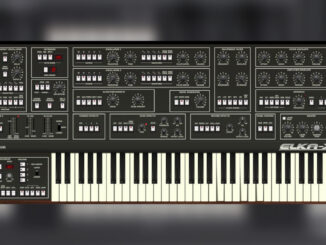Outersect Modeler is Rob Rayle’s new project and is a new physical modeling Synthesizer plugin that takes you on a wild acoustic-modeled trip.
Physical modeling is an exciting synthesis that still contains a lot of undiscovered potential. This is used primarily to model acoustic sounds—for example Modartt. Instead of sampling GBs of sounds, they recreated different pianos using PM synthesis in their Pianoteq software. And this is very successful.
You can also model pluck, string, and other sounds with physical modeling. Rob Rayle, an ex-Avid/DigiDesign developer, has developed Outersect Modeler, an exciting PM synth with great attention to detail.
Outersect Modeler
The developer is Rob Ryle, aka Outersect, and the synth is marketed via the Tracktion platform. According to Rob, Outersect Modeler originates from a life-changing experience at Burning Man. Maybe I have to go there too, to get some new ideas.
Physical modeling synthesis is classically based on an exciter and resonator relationship. This is also the case here. Outersect Modeler offers a customizable resonator section (decay, damping, dispersion, distortion, etc.) and various exciter models.
You get independent plucked string, bowed string, reed, and brass models with different controls. You can use them standalone for recreating specific acoustic sounds or hybrid ones by combining them. The synth uses unique proprietary physical modeling algorithms, says the developer.
Then, you get work with a unique body filter with lowpass, high-pass, and six fully modulatable parametric bands, allowing you to dive deeper in the sound character. Plus, you can customize the pickups of your pseudo-acoustic instrument and work with electric guitar-style feedback.
Modeler focuses on authenticity and expressivity. Rob promises that the synth sounds and behaves like a physical instrument. This includes realistic harmonic jumps, controlled harmonic feedback, or singing characteristics of a violin.
Sounds can be refined in the multi-effects section of Outersect Modeler, consisting of a stereo chorus, delay, and reverb.
Semi-Modularity
Outersect didn’t leave it at that. There is also a powerful modulation engine with a semi-modular concept. It is operated using virtual cables that you can pluck in everywhere. With many connections, this can be a bit messy, but it can always be hidden.
The engine offers three DAHDSR envelopes, three multi-wave, flexible LFOs, and six meta knobs, aka macro knobs. Modeler fully supports DAW automation and MIDI learn. This allows you to map parameters to your keyboard or even on a cheesy keytar; check the official video.
Outersect added a wide range of presets. They range from fine-tuned ones that focus on being super authentic and realistic acoustic instruments to weird, experimental, hybrid instruments like soundscapes. There is something for everyone.
First Impression
Modeler looks exciting. I like that there are different exciter models available and the opportunity to combine them. The GUI is a bit wild-looking, hope this is just the first look. Maybe the design of the GUI also came from another Burning Man trip. Who knows? As a big fan of PM Synthesis,
I am happy about every new entry on the market. I’m curious to check out Modeler in person.
Outersect Modeler is available now for an introductory price of $90,30 instead of $129. It runs as a VST3, AU, and AAX plugin on macOS (native Apple Silicon + Intel) and Windows. A 7-day demo is available on the Tracktion website.
More information here: Outersect (Tracktion)






Be the first to comment